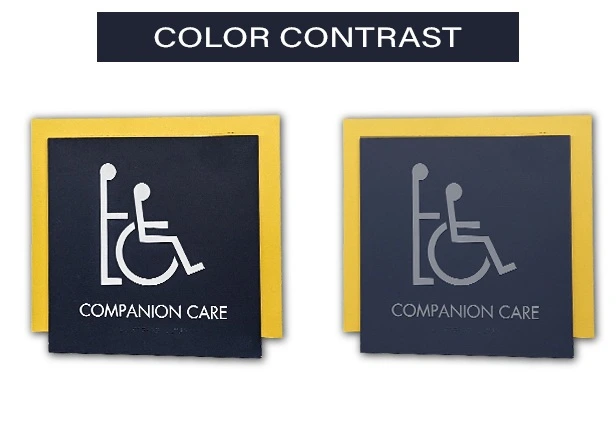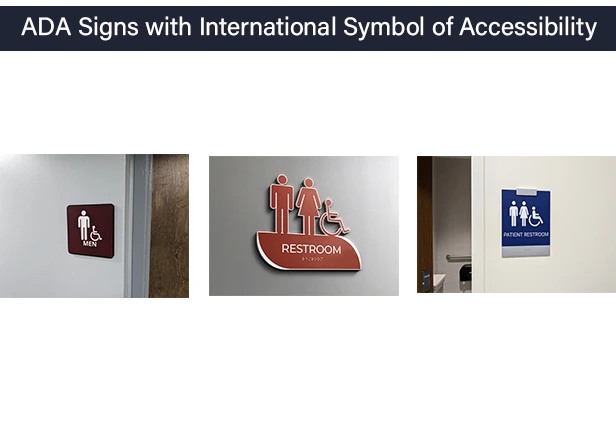Table of Contents
ADA signage for hospitals is more than just directions. ADA signage helps everyone, including patients and visitors, find their way more easily.
ADA signs in hospitals must meet federal standards. These rules set by the Americans with Disabilities Act (ADA) help people with disabilities read and understand your hospital’s signs. Following these federal standards protects your facility from legal issues and improves the patient experience.
This guide shares the 2025 technical specifications and best practices for facility managers, architects, and sign makers. It will help your healthcare facility become fully compliant.
What is ADA Signage for Hospitals is Essential for Healthcare Facilities
The Americans with Disabilities Act (ADA) establishes accessibility standards for public building signage. ADA hospital signage helps people with visual impairments, mobility issues, and other disabilities.
Hospitals usually fall under ADA Title III (Public Accommodations). If they receive public funding, they might also include Title II, which covers State and Local Government services. Signs, like permanent room signs, directional signs, and safety markers, have clear purposes.
ADA signage is a crucial wayfinding tool for people with diverse needs.
Visual Impairment: Requires high-contrast text and non-glare finishes.
Blindness: Requires tactile elements, specifically raised letters and Grade 2 Braille.
Mobility Impairment (Wheelchair Users): Requires signs mounted within accessible reach ranges.
Hospitals need to use these standards for permanent signs. This includes room identifiers, directional markers, and safety indicators. These signs should be placed throughout the facility.
4 Key Reasons Why ADA Compliance Is Essential for Healthcare Facilities
Compliance is not just a cost; it is a critical investment in legal security and patient care.
- Shield Against Legal Exposure and Fines: The Department of Justice (DOJ) actively investigates ADA complaints. Hospitals that do not comply risk large penalties, legal costs, and required retrofitting. This retrofitting often costs much more than installing compliant systems from the start.
- Elevate the Patient Experience: Clear and accessible signs reduce patient stress and anxiety. Patients can find their way without interrupting medical staff, which helps them feel more independent. Happier patients lead to better reviews and greater trust.
- Optimize Staff Efficiency: Intuitive wayfinding minimizes staff interruptions. Nurses and doctors focus more on high-quality care. This change allows the front desk to handle important admin tasks efficiently.
- Demonstrate Inclusive Commitment: Accessible signage is a clear, visible commitment to serving your entire community equally. It helps your hospital provide inclusive and respectful care to every patient and visitor.
Core Technical Standards: ADA Signage for Hospital Facilities
Federal law sets specific rules for ADA signage, particularly ADA Standards §703. These rules ensure signs are accessible to people with visual impairment, blindness, and mobility impairment.
1. Raised Characters and Grade 2 Braille
Signs for permanent rooms must be tactile. This includes patient rooms, exam rooms, restrooms, and surgical suites.
Technical Specification
Raised Characters must be raised 1/32 inch (0.8 mm) minimum.
Use All Uppercase Sans Serif fonts (e.g., Helvetica, Arial). Stroke width must not exceed 15% of character height.
Character Size Between 5/8 inch (16 mm) minimum and 2 inches (51 mm) maximum. The size is measured by the uppercase “I.” This applies to all permanent room signs.
Braille Standard: Must use Contracted (Grade 2) Braille. Dots must be domed or rounded, not sharp. Braille must be positioned directly below the text. The character size is measured by the upper “I”.
These rooms need tactile signs:
- Patient rooms
- Exam rooms
- Restrooms
- Lab spaces
- Imaging rooms
- Therapy rooms
- Staff offices
2. High Contrast and Non-Glare Finish

Contrast and material choice are crucial for patients with low vision.
Technical Specification
Contrast Ratio:
There must be high contrast between the text and the background. For example, light text on a dark background. While the standard is flexible, the industry best practice is a minimum 70% contrast ratio.
Finish:
All sign materials must have a matte, non-glare finish. Glossy signs can cause reflections from hospital lights, making the text hard to read, so they do not comply. This makes the text hard to read.
3. Correct Mounting Height and Safe Installation
ADA signs for hospital doors must be placed carefully. This helps wheelchair users access the doors easily. They also stay safe from any objects that stick out.
Placement Requirement Technical Specification (Inches) Rationale
Tactile Read Zone: The baseline of the lowest character must be 48″ minimum. The baseline of the highest character must be 60″ maximum. This ensures reachability for all users, including those in wheelchairs.
Sign Location: Mount the sign on the wall next to the latch side of the door. Never mount the sign on the door itself. This location is standardized for predictable wayfinding.
Clear Floor Space
18″ x 18″ minimum unobstructed floor space centered on the sign.
Allows a wheelchair user or person with a cane to safely approach the sign.
Protrusion Limit: Signs mounted below 80″ AFF (Above Finished Floor) must not project more than 4 inches into a pathway. This prevents head-strike hazards for people with visual impairments.
4. Clear Pictograms with Text Descriptors

Visual symbols, like the International Symbol of Accessibility (ISA) or restroom signs, must always have text.
- The pictogram must occupy a dedicated field of at least 6 inches high.
- A text description is required. It should include raised text and Braille. Place it just below the pictogram.
Common hospital pictograms show:
- Wheelchair accessibility
- Restroom designations
- No-smoking areas
- Emergency exits
- Directional arrows
- Assistive listening devices
Pictures alone don’t meet ADA standards. Always add text descriptions.
Types of ADA Signage for Hospitals You Need
Permanent rooms need tactile signs. Other wayfinding elements must meet visual ADA standards. This includes contrast, font, and mounting height.
Types of Signs That Require Full Tactile Compliance:
These signs show important areas and are key ADA signs for hospital compliance:
Room Identification Signs
These room identification signs tell people what each room is. These signs use either names or numbers consistently. Pick one system and stick with it, facility-wide.
Examples of these signs are “Radiology Department” or “Room 215.” They require raised letters and Braille on these signs.
Directional and Wayfinding Signs
These signs guide people through your building. They point toward departments, elevators, exits, and parking areas.
Directional signs need clear text and good contrast. They don’t require Braille unless they mark a permanent location.
Some of the examples of these signs are
- Emergency Department →
- Elevators ahead
- Main entrance this way
- Parking garage Level 2
Informational Signs
These signs explain policies and procedures. They tell visitors about:
- Check-in processes
- Visiting hours
- Patient rights
- Safety rules
- Service availability
These signs make this information easy to read from several feet away.
Safety and Regulatory Signs
Hospitals must mark all safety features clearly:
- Fire exits
- Extinguisher locations
- Stairwell markers
- No smoking zones
- Hazardous areas
These signs protect everyone in your building.
Accessibility Feature Markers
These show people where accessible services are located. Examples of these signs include
- Wheelchair entrances
- Accessible restrooms
- Accessible parking
- TTY phones
- Hearing assistance devices
The international accessibility symbol helps people spot these features quickly.
Types of Signs That are Usually Visual-Only (but must comply with contrast and size):
Certain signs are legally exempt from tactile requirements. These signs guide traffic and do not mark a fixed functional space:
- Building addresses
- Parking signs (unless identifying accessible spots)
- Directional/Wayfinding Signs (unless marking a permanent destination)
- Temporary signs (used for less than seven days)
- Building directories and facility maps
- Employee names, logos, or company letters on doors
- Directional Arrows and Banners
How to Implement ADA Signage Successfully
Getting quality ADA signs right the first time is more cost-effective than fixing them later.
Step 1: Strategic Planning: Develop a consistent naming architecture for your entire facility. Choose a standard style and material, like photopolymer or rigid acrylic. This will help ensure compliance and durability.
Step 2: Expert Partnership: Work with sign professionals who specialize in healthcare. They ensure the Braille is Grade 2, heights are exact, and materials are non-glare. This helps reduce legal liability for your facility management team.
Step 3: Digital Integration: Use modern digital screens for real-time updates and interactive maps. Remember: Digital signs supplement, but do not replace, the core physical ADA signs. Digital systems still need high contrast and proper mounting.
Step 4: Continuous Auditing: Regularly check ADA signs for hospitals for damage, fading, or wrong placement. Do this after any maintenance or construction. It also improved patient satisfaction and staff efficiency.
The Real Value of Quality ADA Signage
Some administrators worry about signage costs. But think of it as protection, not an expense.
Quality ADA signage:
- Avoided Risk Investment Benefit
- Lawsuits and Penalties – Legal protection and reduced risk exposure.
- Patient Anxiety and Stress – Improved patient satisfaction and HCAHPS scores.
- Staff Interruptions – Increased medical staff efficiency and focus.
- Costly Retrofits – Higher quality, long-lasting materials, and correct installation the first time.
Budgeting for quality ADA-compliant materials and expert installation helps your hospital. It boosts your reputation, improves efficiency, and ensures fair treatment for all patients.
Ready to make your healthcare facility fully accessible and legally secure?
Your hospital’s signs show your dedication to patient safety and equal access. Meeting the 2025 ADA requirements makes it easier for all visitors to move around safely.
We at ALTIUS Graphics specialize in ADA-compliant signage for healthcare facilities. Our team knows federal accessibility requirements inside and out. We help hospitals create signage systems that improve wayfinding, ensure compliance, and reflect organizational values. Reach out to learn how we can help your facility.
Read More:
11 Common ADA Violations to Avoid in Interior Signage (How to Fix Them)
Top Questions to Ask Before Ordering Interior Signage in 2025
FAQs on ADA Signage for Hospitals
Q1. What signage in a hospital must comply with the Americans with Disabilities Act (ADA) standards?
Signage that identifies permanent rooms or spaces (such as exam rooms, restrooms, departments), signs showing accessible routes, and directional or informational signs for public areas must meet ADA signage standards.
Temporary signs (for short-term use) typically do not need tactile (raised) text and Braille.
Q2. What are the key design requirements for ADA-compliant signs in a hospital facility?
Key design requirements include: raised tactile characters, Braille (Grade 2) beneath the tactile text, high contrast between text and background, non-glare finish, sans-serif fonts, and proper mounting height and location (e.g., on the latch side of the door) so that people with visual impairments or mobility challenges can locate and read them.
Q3. Does the ADA signage requirement differ for healthcare facilities (like hospitals) compared to other commercial buildings?
Yes, in the sense that healthcare facilities often accommodate more people with disabilities, so wayfinding signage, accessible route indicators, and patient-navigation signage become especially important. The technical standards for signage remain the same, but the application may be more extensive in hospitals (for example, signage for clinics, exam rooms, accessible entrances) to ensure safety and ease of navigation.
Q4. Can hospital signage be branded or customized and still meet ADA compliance?
Yes, customization (such as using hospital brand colors or logos) is possible provided the sign still meets ADA-specific requirements: adequate contrast, correct tactile/text elements, proper mounting, non-glare finish, etc.
But be cautious: aesthetic elements must not interfere with the accessibility features.
Q5. Why is ADA-compliant signage especially important in hospitals?
It is important because hospitals serve a broad population including individuals with mobility, visual, auditory, or cognitive disabilities. Clear, accessible signage helps patients and visitors find their way, reduces stress and confusion, improves safety (especially in emergencies), supports inclusive care, and helps hospitals meet legal obligations.
Also, compliant signage reduces the risk of legal action or regulatory penalties.
Author
-
Sidd is a passionate content creator at ALTIUS Graphics, where signage, design, and storytelling come together. Inspired by bold visuals and impactful branding, he writes with clarity and purpose, covering everything from ADA-compliant signs to eye-catching vehicle wraps. Through every blog, Sidd shares insights that help businesses transform spaces and elevate their brand visibility with confidence.


